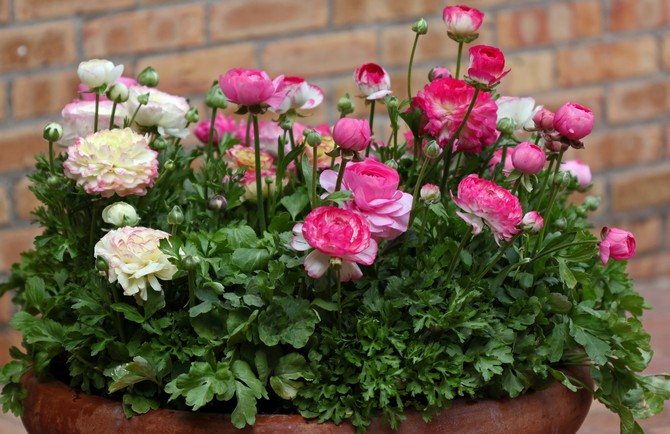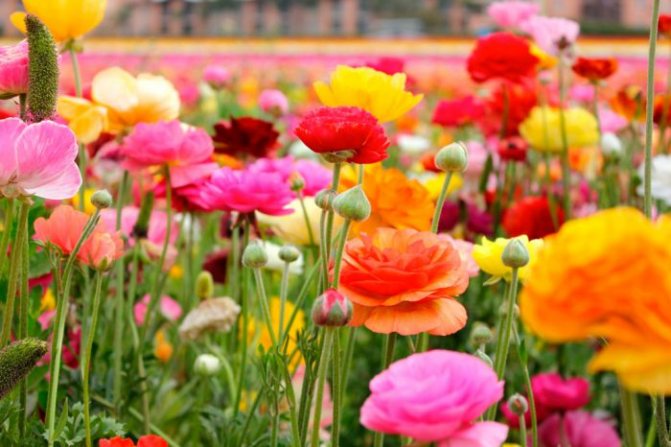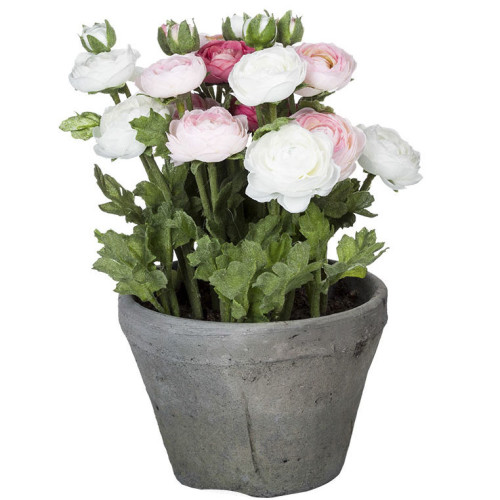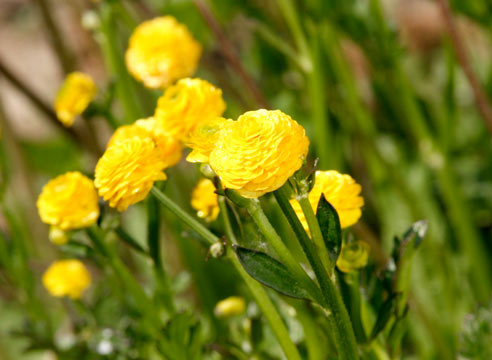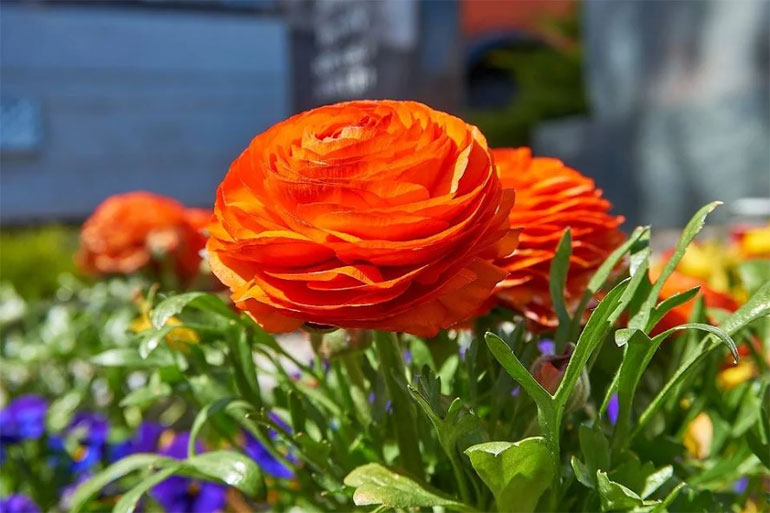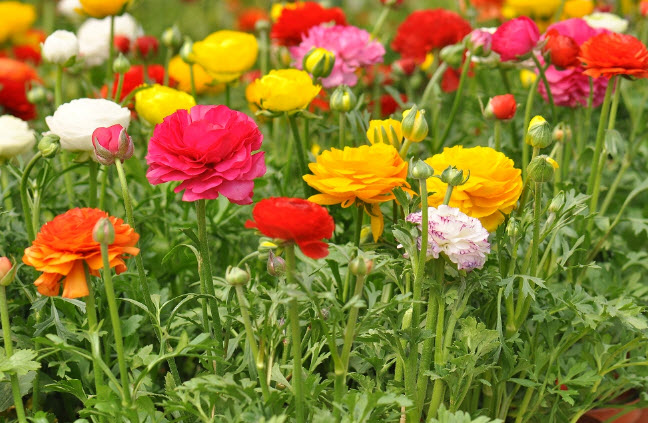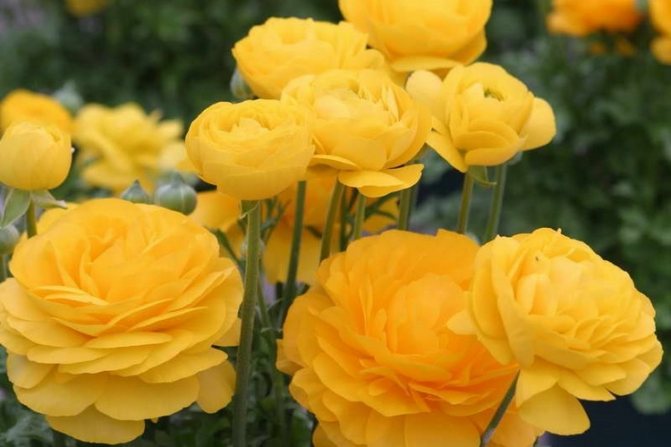Varieties and types
Asiatic buttercup (aka garden buttercup, decorative ranunculus) is the most decorative of all species, wildly growing in the southeastern regions of Europe and in Asia Minor. The stem of this perennial plant grows in length only up to 50 cm, but the diameter of the flowers is larger than that of the caustic plant - 4-6 cm.
The variety of garden forms of the Asiatic buttercup includes varieties with bright double and semi-double flowers, white, pink, red, orange and purple flowers.
For example, buttercup rose bicolor is a variety up to 25 cm high, which has double white flowers with petal tips painted in a pinkish tint, which makes it look like a miniature rose;
And the pearl picoti buttercup has white flowers with purple petal tips.
Buttercup varieties are conventionally divided into the following 4 groups:
turban-shaped buttercups with large spherical and densely double flowers;
Persian buttercups, with simple or semi-double flowers, undersized;
French buttercups with only semi-double flowers;
peony buttercups with large double flowers.
In our climate, peony buttercups, which are less demanding on weather conditions, are especially popular. Forcing buttercups at home is a rather painstaking process, but for those who have the strength and patience, it is quite possible to take on this business.
Wild species of buttercup
Buttercup caustic is a typical representative of this genus, growing in Eastern and Central Europe, as well as in the regions of the Caucasus and Western Siberia. The perennial plant reaches 1 meter in height, can be slightly pubescent, with bright yellow flowers up to 2 cm in diameter, rather winter hardy and not demanding to care for (especially if you plant it on the banks of a stream or reservoir).
Buttercup creeping can be seen in a variety of places, from Europe to Africa, mainly in shaded areas of the shores of lakes and rivers, forest swamps, fields. Its height is approximately 40 cm.
Poisonous buttercup grows in the wetlands of Siberia, the European part of Russia and the Far East, covering the banks of reservoirs and ditches. Representatives of this species are either annual or biennial plants up to 45 cm high, with small (up to 1 cm in diameter) light yellow flowers.
Buttercup water - has small white flowers, yellow in the middle, rising above the water surface by 3-10 cm. It grows in any ponds and streams. The shallow waters are also suitable for growing the gmelin buttercup, characterized by small carved foliage and small yellow flowers.
Buttercup field
Also one of those species that prefer wetlands, where it can reach 60 cm in height. Its yellowish or golden color, not grouped flowers, blooming on the tops of the shoots, along with other parts, are widely used in medicine, and the tubers are widely used in the production of food additives.
Kashubian buttercup is a perennial representative up to 50 cm high. It differs in the presence of round-reniform or rounded basal foliage with denticles along the edges of the vegetative stems.
Buttercup multiflorous is relatively high (up to 80 cm), its stem and leaf petioles are pubescent. Diameter of bright yellow flowers - no more than 3 cm. Wild multiflorous buttercups are ubiquitous in forests and meadows.
Buttercup sulfur-yellow (sometimes called "Arctic buttercup") grows in Siberia, Arctic Europe, North America in tundra swamps, near snowfields.It is characterized by a height of no more than 25 cm. The flowers are arranged singly, less often in two, 1.5-2.5 cm in diameter, their color corresponds to the name of the species.
Buttercup borecel (not officially - white buttercup) grows in the mountains of Central Europe as a perennial with pubescent shoots up to 60 cm tall. Its garden forms include varieties with large double flowers of white and golden yellow flowers. High winter hardiness allows this species to withstand frosts down to -29 ℃.
What does ranunculus or garden buttercup look like?
Although, perhaps, every person had heard about the buttercup, not everyone knows its description.

Ranunculus is a real flower bed decoration
What family does it belong to
Buttercup (ranunculus) is a member of the Buttercup family, which includes, according to various sources, from 1200 to 2000 different plants. Representatives of this family are found in almost the entire northern hemisphere - from temperate latitudes to the Arctic. Moreover, in these parts you can see about 13 genera of a flower!
Briefly about the history of appearance
Ranunculus are flowers that are well known to mankind for more than a thousand years. Even in the works of the ancient scientist Pliny, there are references to this graceful plant.
It is interesting! From Latin, the name of the flower is translated as "frog" - and all because it is often found on swampy soils.
Initially, it was home to Iran and Syria, but over time it became popular among Europeans, and then spread throughout Europe. Later he went out of fashion, but in recent years florists have again become interested in him and are intensively engaged in the development of new varieties.
Plant characteristics
This is a fairly extensive genus, therefore the flowers in it are very different from each other.
On average, their height ranges from 20 to 80 cm. The plant grows well both in pots and in the open field. The shoots are very similar to the dahlia - both in stems and leaves. The roots have an interesting shape - they look like crow's feet.

The flower is great for bouquets
When a flower is just starting to open, it looks like a rose. Well, the fully opened buds look more like an elegant poppy. The similarity is enhanced by the color - most varieties have deep orange or red flowers.
On a note! Some types of ranunculus are used in folk medicine to treat skin diseases.
The plant is perennial. That is, by planting a tuber in the garden once, and creating optimal conditions for growth, a flower lover can be sure that every year the plant will delight him with gorgeous flowering.
2. Varieties:
2.1. Asian ranunculus - Ranunculus asiaticus
Attractive flowering bulbous perennials 30 - 60 cm high with erect shoots and dark green, glossy, carved leaves, reminiscent of parsley. The flowers are wide open, cupped, resemble a poppy, the size of the flower reaches 5 cm, can be painted in yellow, pink, red, white shades. Anthers are black.

2.2 Ranunculus Persian - Ranunculus Persian
A variety of the Asiatic buttercup often found in flower culture. Depending on the specific variety, the height of the plant can vary from 25 to 60 cm. Plants of this species have simply huge, double flowers with many rounded, thin petals. The flowers can reach 15 cm in diameter. The flower shades are often delicate, pastel, in a very diverse range of colors, except perhaps only black and blue shades.

2.3 Ranunculus bulbosus - Ranunculus bulbosus
A flowering perennial herb with a height of 10 to 30 cm. Bushes have thin, erect stems and dark green, carved, complex leaves on long and thin petioles. Leaves can consist of several segments and are arranged in succession. The flowers are solitary, golden yellow, cupped, with rounded, wide, glossy petals, reaching a diameter of 1.5 - 3 cm.This variety is often found in gardens as a weed.
Ground parts of this plant used in homeopathy to treat shingles, intercostal neuralgia, rheumatism and diseases of the upper respiratory tract, relief of epileptic seizures.
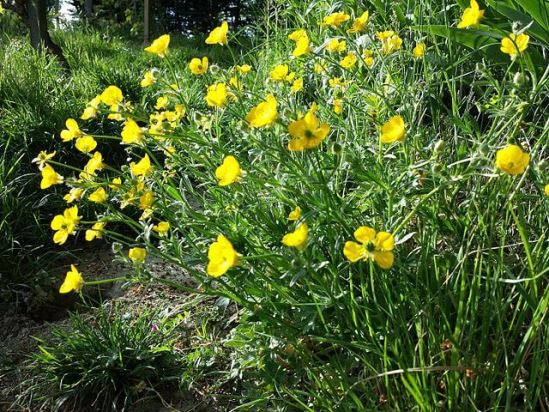
2.4. Ranunculus creeping or repens - Ranunculus repens
Small plants, reaching a maximum height of about 30 cm. Plants have lodging, thin stems and are able to form dense grassy mats over time. Leaves are glossy, dark green compound - consist of three toothed segments. Peduncles are abundantly covered with silvery pubescence. The flowers are golden yellow, about 2.5 cm in diameter, appear on plants in May and almost until frost.

3. Summing up - 7 secrets of success:
- Growing temperature: after planting - cool conditions at a temperature of 12 - 14 ° C, with the appearance of green mass, the temperature of the content is increased to 20 ° C.
- Lighting: shading from direct sunlight during the daytime in spring and summer, sunbathing in the morning and evening.
- Watering and air humidity: well-moistened substrate during the growing season and budding, almost dry soil after flowering and wilting of leaves. It is desirable to increase the air humidity.
- Pruning: Removing wilted buds and old, withered leaves.
- Substrate: Should have a neutral pH and excellent drainage.
- Top dressing: during the entire growing season - with mineral fertilizers or organic matter, during the dormant period they are not fed.
- Reproduction: seeds sown in spring and bulbs.
You may also be interested in:
Eustoma
Anemone
Butcher
Care in the garden
After planting in the garden, caring for the buttercup is not difficult even for inexperienced gardeners.
Watering
Ranunculus often has enough moisture from natural rains. During dry periods, additional watering will be required, since he loves regular moisture, and a lack of water will immediately affect the intensity of flowering and slow down the appearance of new buds. In dry weather, the buttercup should be watered every 2 to 3 days, using settled or rainwater.
In watering, it is important to observe the measure: it is necessary to ensure that excess water does not form puddles at the base of the stem. Signs of over-watering - the appearance of a white fungal bloom on delicate leaves and the shedding of new underdeveloped buds
With a lack of water, brown spots appear on the leaves, and the buds do not reach their normal size and form small flowers that fade very quickly.

Loosening the soil
One of the main requirements for successful ranunculus cultivation in the garden is periodic loosening of the soil, which allows oxygen to flow to the root system. In order to achieve good permeability, you need to weed the soil near these flowers at least once a week.
Weeds must be removed at exactly the same frequency, because their overgrown root system can disturb the fragile roots of ranunculus, which will cause the death of the ground parts (leaves, stems and buds).
Top dressing
Fertilizing doesn't just stimulate buds, sometimes a lack of nutrients can wipe out a plant entirely. Buttercup is very responsive to fertilizing flowering plants. It should be applied once every 2 weeks on wet soil. It is impossible to do this more often, hoping for abundant flowering: an excess of potassium can cause root burns and long-term illness. After flowering is over, the need for feeding ends.
How to prolong flowering
In order for the ranunculus to bloom actively all season, it is necessary to cut off wilted inflorescences from the stems in a timely manner. Firstly, it initiates the emergence of new buds, and secondly, it will save the flower's energy, which would be spent on the formation of seed pods.

It is impossible to pick off dried inflorescences: pathogenic bacteria can settle on an uneven scrap.It is best to use a sharp knife or garden shears for this. If this is not done, then there may be no buds left on the buttercup at all - it will only have large leaves that are not of decorative value.
Diseases and pests
Most buttercup diseases are associated with improper watering. You can quickly get rid of them by adjusting the periods of water intake and drying out of the soil. Excess moisture can cause the development of powdery mildew, which will need to be treated with fungicides.
Since the juice of this plant is quite bitter, not all pests can withstand it. Cabbage can feast on leaves, which eat fresh greens at the larval stage. Sometimes aphids, spider mite net or adult thrips can be found on the plant. To get rid of them, you will need to treat the plant with wide-spectrum insecticides for open areas three times with an interval of 7 days.
How to plant and grow buttercups at home

Garden buttercups can be grown both outdoors and in a pot
Many growers agree that it is possible to plant ranunculus indoors. In a cold climate, buttercups planted in the ground often suffer from a sharp drop in temperature and die already for 2-3 years. But in at home they will bloom for several years in a row. In this case, the period will last longer, and the bud will be larger.
Required materials and tools
To grow buttercups from seeds, you will need the following:
- planting material;
- substrate (40% peat, 60% perlite);
- container for disembarkation (box, container or pot);
- film or piece of glass.
Step-by-step instructions for growing ranunculus from seeds

Delicate flowers can be simply planted from seeds.
The germination rate of ranunculus from seeds is rather low. You should also take into account some of the features of harvesting the seeds of this flower. They are harvested in the middle of summer. But in the process, you will need to make a lot of effort.
The reason is that ranunculus has extremely small seeds that easily spill out onto the ground with any careless touch of the flower. If you want to collect planting material with minimal losses, then wrap the buds with gauze as soon as they bloom
Then shake out the seeds periodically. In order to ensure good germination, the planting material must be stored at a temperature of + 18 ... + 22 ° C.
For the rest, you must adhere to the following sequence of actions:
- Immediately before planting, the seeds should be soaked in water for a short time, for about 2-4 hours.
-
At this time, you should start preparing the substrate. For its preparation, we take sheet, peat soil and sand in a ratio of 1: 1: 0.5. The resulting mixture must be rubbed through a coarse sieve. Black soil enriched with peat is also suitable for cultivation.
-
Lay a drainage layer in the prepared container so that water does not stagnate inside. To do this, make several holes in the bottom and lay a layer of material. It can be expanded clay, shards of clay pots, broken red brick, crushed stone, gravel, vermiculite.
- The container is filled with potting soil.
- After that, seeds are placed on the surface and lightly sprinkled with soil (layer no more than 3-5 cm).
- Using a spray bottle, gently moisten the soil so as not to wash off the planting material.
-
The box with future buttercups must be covered with transparent glass or foil. We leave it in a room with a temperature of + 10 ... + 12 ° C. When water droplets form on the film, the glass is removed to remove them. During this time, the seedlings will ventilate a little.
-
After about 3 weeks, with proper care and observance of the temperature regime, small sprouts of buttercups will appear. This suggests that the shelter is no longer necessary - it needs to be removed.
-
As soon as 5-6 leaves appear on each sprout, the plants can be dived and planted in different pots. The containers are prepared in the same way as the container for sowing seeds.
The pots must be moved to a room with a temperature not exceeding +22 ° C. An excellent place for ranunculus growth will be window sills on the south side of the house. As soon as stable warm weather sets in, the plants can be taken out to the balcony.
Diseases and pests
| Description of the problem | Cause | Solution |
|---|---|---|
| Ranunculus does not bloom | Not enough nutrients. Too much watering. The light regime is violated. | Feed with potash fertilizers. Reduce watering. Move to another location. |
| Drops buds | Abundant watering. decay of the root system. | Reduce watering. Expose to the sun, dry. Transfer to partial shade. |
| Foliage curls. The plant slows down growth | Nematode disease. | Dig up the tubers, clean them as much as possible and dip them in water at a temperature of + 55C. Replace the primer. |
| Leaves are covered with yellow spots and become sticky | Spider mite | Fitoverm and Neoron insecticides will help. And also a soap solution: infusion of garlic, onion peel. |
Planting ranunculus outdoors in spring
Ranunculus are rhizome perennials with a short dormant period, during which small finger-like tubers retain nutrients and moisture. Vegetation lasts from early spring, when the arrival of heat and moisture stimulates the awakening of sprouts, and until autumn. At home, tubers winter in the ground, but in central Russia they must be dug up and stored in a dry room at a temperature of 14–17 ° C.
The time to plant ranunculus outdoors in spring depends on the climate of the particular region. Suitable conditions in the middle lane begin in mid-April and persist until the end of May. The soil in the garden has warmed up enough, but it still stores the thawed moisture. This will help the Asiatic buttercup to awaken to form friendly shoots.
On this topic:
BACK
FORWARD
1 in 199
If the ranunculus rhizomes stored in the fall or bought the day before have dried up, before they reach the flower beds, the tubers are immersed in a growth stimulator solution for 12-24 hours and treated with potassium permanganate.
To make it easier to care for ranunculus in the open field, planting is planned where the buttercups will be well lit, but will not be affected by the wind and the hot midday sun. If the groundwater at the site is close, drainage must be provided, and a loose fertile substrate is also prepared.
In the spring, planting ranunculus in open ground is carried out to a depth of 5–7 centimeters, while leaving a gap of about 15 cm between the plants, which will be required for the growing rosettes of cut leaves.
If the plant receives proper care, young tubers appear on each adult rhizome in the fall, which are separated and also stored until spring. The next year, the babies are planted along with other buttercups, and the strongest ones can bloom contribute to the natural rejuvenation of the collection.
Planting Buttercups Garden in open ground
Although Garden Buttercups are considered unpretentious, they should be grown, adhering to a number of rules.
Boarding time
The best time for planting Garden Buttercups in open ground is the second half of May. By this time, both the air and the earth will warm up.
Growing place
The plot for growing Garden Buttercups should be in partial shade. It should definitely not be in a draft or in an open place, since strong gusts of wind negatively affect the plants. The most favorable place is next to a low tree or shrub. If the site is open, then under the influence of direct sunlight, the decorative qualities of Buttercups will suffer, flowering will become short-term, not abundant.
Preparing the soil for planting flowers
The site must be prepared in the fall. It must be dug to the depth of the shovel bayonet. It is advisable to feed the soil with rotted manure.
If the acidity of the soil is high, then you can deacidify it with lime or bone meal.So that there is no stagnation of water on the site, no rotting of the bulbs occurs, a drainage layer of crushed stone or expanded clay is required.
The method of planting seedlings in open ground
- The landing holes should not be deep. The interval between the landing pits is at least 15 cm.
- The bottom of the planting holes is covered with a drainage layer consisting of expanded clay and sand. If the seedlings were grown in peat pots, then the seedlings are planted directly in them. If in a plastic container, then it is neatly cut on the sides, the sprouts are removed and placed in the hole, sprinkled with earth.
- The soil is slightly compacted, spilled with settled water at room temperature. The flowering of seedlings will begin only next year.
Planting tubers
Before planting, the tubers must be dipped in water for a day or soaked for 6 hours in a weak solution of potassium permanganate, after which they are wrapped in a wet cotton napkin. As soon as the nodules are swollen, they can be planted in the ground.
The optimal time for planting nodules is mid-May. It is desirable that the air temperature does not fall below + 12 ° C. If suddenly the thermometer dropped below, the seedlings must be covered.
Planting holes are made deeper than the size of the tubers. The bottom is covered with a drainage layer. The tubers are placed in the pits with the nose down. The roots deepen by about 7 cm. After planting, the tubers are sown with water at room temperature. In about a week, the first shoots will appear.
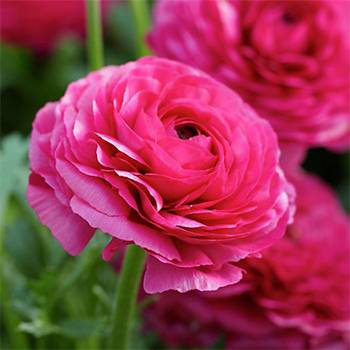 Buttercups Pink
Buttercups Pink
Diseases and pests
Ranunculus can suffer from various diseases, as well as from insect pests. Let's consider the possible problems and ways to solve them. The plant is susceptible to fungal diseases. Of particular concern are indicators such as white mold or brown spots. I must say that most often this problem occurs due to excess moisture. To save the situation in case of a weak lesion, you can use a light blowing. In serious cases, the flower must be destroyed in order to exclude the possibility of the spread of the disease.
We must not forget about harmful insects, which can significantly complicate the life of a grower. This is especially true for cabbage butterflies, nematode worms, aphids, ticks and thrips. An indicator of a pest problem is mainly white or silvery spots on the leaves. In this case, insecticide treatment will help. However, it is no secret to anyone that preventing a problem is much easier than coping with it. Therefore, it will be useful to think about prevention. If you treat the flower with a 0.2% solution of mercaptophos 1-2 times a week, you can forget about most of the troubles.


In the next video, you will find the secrets of a successful ranunculus planting into the ground.
Reproduction
During the summer, the root tubers of the garden buttercup form several daughter root cones, which, when dug up, at the end of summer, are carefully separated. They are stored and planted next spring. "Daughters" will bloom in a year or two.
You can propagate the garden buttercup by seeds. But getting your own seeds is quite difficult (the seeds quickly become sterile, and the viability is preserved in a very small number of seeds). But the seeds can be purchased at the flower market or shop.
Seeds are planted at the end of February - in March, in light loose soil (a mixture of leafy or peat soil and sand), lightly sprinkled with soil, and moistened with a spray bottle. Maintain a constant temperature within 10-12 ° C, but not higher, and constant humidity - by covering the container with a film (do not forget to ventilate). Seedlings appear in 2-3 weeks. Then the container with the seedlings is moved to a warmer place, cultivation is optimal at 20 ° C.
Seedlings require a lot of sunlight, they are placed on the south window and, if necessary, supplemented with light. In mid-May, seedlings are planted in open ground.Flowering occurs only after a year. In the year of sowing, flowering can be observed, but very little.
Old and modern varieties
The selection of ranunculus dates back several centuries, hundreds of varieties have been bred with various colors, petal shapes, and the degree of terry. In Europe, it is very popular as a container culture and decorates windows, balconies, verandas, and gazebos everywhere. In our gardens, this plant is a rarity, which is evident even from the name of the varieties sold. Basically, there is a name (garden buttercup or ranunculus) and a color designation (yellow, pink).
Let's try to understand the assortment in more detail. All garden flower forms are usually grouped into 4 groups.
- The Persian variety is the oldest and includes tall varieties for cutting. Flowers are large, double or semi-double, bloom in spring.
- Turkish or Turtle-shaped buttercups are distinguished by petals twisted inside the flower, they are also called peony-shaped.
- French ranunculus is less terry than other forms, white to purple in color, blooms in summer.
- The Asian group is the most extensive and continues to grow through the efforts of breeders. A feature of varieties and hybrids of the Asian species is low-growing bushy plants that are quite resistant to heat and bloom throughout the summer.
Here are examples of the most popular varieties and hybrids of crops that vegetate quite productively in our climatic conditions.
- Bloomingdale, we sell tubers as Blooming Valley - an extensive group of hybrid ranunculus, coming in one color (white, red, yellow, pink, orange) or as a mix of colors.
- Color Carnival is a beautiful variety with high stems up to 70 cm, perfect for cutting. Flowers of warm colors create a bright sunny island in the garden, above which butterflies and insects are constantly circling.
- Superbissima is a tall variety, mainly with white and red semi-double flower heads.
Varieties for a bouquet
Diseases and pests of ranunculus
Ranunculus has excellent immunity, but it also has some ailments. This is mainly due to inappropriate growing conditions and mistakes in grooming.
The most common powdery mildew is a fungal disease that occurs due to frequent and abundant watering, which leads to rotting of the roots and dropping of the buds. It is characterized by a gray-brown loose bloom on the leaves. It is possible to prevent the death of the plant if the amount of moisture is reduced. Affected seedlings are dug up and destroyed.
No less danger comes from various pests. The main list is presented in the table:
| Parasite name | Characteristics and symptoms of the lesion | Control methods |
| Nematodes | Small worms, settling mainly on the roots and tops. A number of signs serve as an alarming signal of their appearance: a sharp wilting, the appearance of brown spots on the foliage, and growth retardation. To establish an accurate diagnosis, it is recommended to dig up the flower and examine the tuber for the presence of shapeless growths (galls). | The rhizomes are immersed in water at a temperature of 45-50 ° C. Withstand, about 30-40 minutes. |
| Spider mite | It feeds on the juice of the green component of the plant, thereby depriving it of its vitality. A yellow speck appears on the stem and leaf plates. Gradually, the flower withers and dies. | The following special acaricide preparations effectively help to get rid of pests: Vertimek, Fitoverm, Aktellik, Akarin and others. Processed according to the instructions on the package. It is recommended to alternate means, as the parasites quickly adapt to everything. |
| Thrips | Another type of pest that lives by sucking nutritious juices from the plant part. Symptoms: spots and stripes of a silvery color chaotically located on the leaves. As a result, the foliage falls off, and the buds shrink, never having time to open. | Insects are quite problematic to eradicate, since they tend to fly from one object to another. Treatment is carried out weekly with insecticides: Iskra, Vertimek, Inta-vir, Biotlin.
Folk remedies are no less effective - crushed dandelion roots (50 grams) are poured with a liter of boiling water. Insist 2-3 hours. 1 liter of warm water is added to marigolds (50-60 g) and kept for 2 days. Then it is filtered. Pour tobacco leaves with slightly warmed water in a ratio of 1:10. Insist for about an hour. A sick plant is sprayed with similar tinctures every other day until complete recovery. |
Planting buttercups
You should not expect flowering from garden buttercups obtained from seeds already in the first year. But the plants are still planted in the ground in the first year of cultivation and adhere to the agricultural technology typical for adult buttercups - with planting in late spring and digging for the winter.
It is possible to plant young buttercups obtained from seeds only when the spring frosts pass, not earlier than May. Much more difficult is the question of where to plant buttercups - in garden soil or containers, which will then be displayed in the garden. Ideally, for active development and flowering, buttercups need a low temperature, about 15-20 degrees, they are sensitive to the vagaries of the weather, they require stable humidity, which is easy to control by watering. And that is why in the first year it is easier to grow them in separate containers, and not in the ground.
When grown on an industrial scale, buttercups are sown and grown in boxes, simply by taking them out into the garden for the summer. This approach is very effective, it allows not only to control the conditions, but also not to lose plants as a result of unexpected cold snaps or extreme heat, transferring them from place to place. But caring for buttercups in a container culture will require complex, constant attention, the plants will depend on you in everything.
When planted in soil, caring for the plants is much easier. So the choice is really not so straightforward. Of course, some of the plants can be left as indoor, and those growing in greenhouses can be further grown there.
Buttercups can also be planted in ordinary flower beds, borders, on a flower bed for summer houses, but then watering will have to be carried out regularly. The quality of the soil is of no less importance. The soil should have a light, porous texture and high nutritional value. The reaction of the soil should be neutral. And one more nuance: buttercups should be grown in protected, comfortable areas, without drafts and cold winds.
Buttercup is planted in spacious, deep pits with drainage laid on the bottom. Buttercups are transferred along with peat pots or a large clod of earth, being careful not to disturb the soil clod around the rhizome. After installing the plant, while maintaining the previous level of deepening, fill up the soil, slightly compact it and immediately carry out deep watering, after which, if necessary, fill up the soil again.
At first after planting, to protect against possible night frost, buttercups can be covered with non-woven materials. This is how plants adapt better and bloom earlier.
During the entire stage of active vegetation and flowering, buttercups require enhanced care:
- For buttercups, one cannot do without regular feeding with a frequency of 1 time in 2 weeks and without quite specific, only phosphorus-potassium fertilizers. Some of the procedures can be replaced by mulching the soil with organic matter and adding wood ash.
- Watering is carried out during periods of drought, restoring comfortable soil moisture and compensating for any vagaries of the weather. The soil for buttercups is not allowed to dry completely.
- Faded shoots are removed in a timely manner, along with the entire peduncle.
- Weeding is carried out as often as possible, complementing the procedure by loosening the soil.
- daughter tubers;
- separation of bushes.



